Hydrographic and impairment statistics were derived using the 1:24,000 scale (1:63,360 in Alaska, except for Bering Land Bridge National Preserve, Cape Krusenstern National Monument, Denali National Park, and Glacier Bay National Park, which have been updated to 1:24,000 scale) U.S. Geologic Survey's (USGS) National Hydrography Dataset (NHD) NHDinGeo data model. The methods explained below assume that the reader has some familiarity with the use of geographic information systems (GIS), particularly ESRI's ArcGIS. Each national park unit was processed within its own personal geodatabase, which included many feature classes such as hydrography, impairment data, and the park boundary. For parks that transverse more than one Watershed Boundary Dataset subbasin (the distribution unit for NHD data), the hydrography from each subbasin was combined into one geodatabase using the USGS "NHD Dataset Merge Utility."
Within each park geodatabase, the project focused specifically on five different NHD feature classes to derive hydrographic statistics:
| Feature Class | Description |
|---|---|
| NHDFlowline | The core linear network of the surface-water drainage system primarily consisting of streams, canals, and artificial paths through polygons. |
| NHDWaterbody | Polygons representing areal hydrographic waterbody features such as lakes, swamps, and reservoirs. |
| NHDArea | Polygons representing areal hydrographic landmark features such as two-dimensional streams or canals (i.e. both left and right banks appear on the map) and oceans. |
| NHDPoint | Points representing hydrographic landmark features such as springs, gaging stations, and waterfalls. |
| NHDLine | Line features representing linear hydrographic landmark features such as reefs and nonearthern shores. |
More detail on the NHD including technical references, tutorials, applications, and stewardship information can be obtained on the USGS NHD website.
Clipping the NHD
All NHD feature classes of interest were clipped to the park boundary contained in the NPS Land Resources Division's (LRD) administrative boundaries dataset. As of September 2018, approximately 90% of the boundaries (375 out of 419 park units) in the administrative boundaries dataset have been endorsed by the LRD. The other boundaries in the dataset originated from a variety of sources generally constituting the best available GIS boundary until updated by the LRD. Park boundaries are dynamic as Congress may expand, contract, or otherwise modify park boundaries. As better boundaries become available, WRD can reprocess a park to update its hydrographic and impairment statistics based on the improved boundary. More information on park boundaries can be found on LRD's website (intranet).
A clipper polygon was used to account for any adjacent water features. The clipper polygon is an auto-complete polygon that is adjacent to the park boundary and is digitized to include areas where adjacent water features occur. When a park has adjacent hydrography, the clipper polygon was used to clip the water features as opposed to the park boundary.
Attributing for Adjacencies
Adjacencies were defined as any water feature that shares a boundary with a park. It is important to note that identifying adjacent hydrographic features may include some level of subjectivity and require a certain degree of judgment by the data processor. Other sources of information, such as reviewing land segment maps and contacting park staff, were utilized whenever possible to verify adjacent features. Below are some examples of adjacency and how they were dealt with:
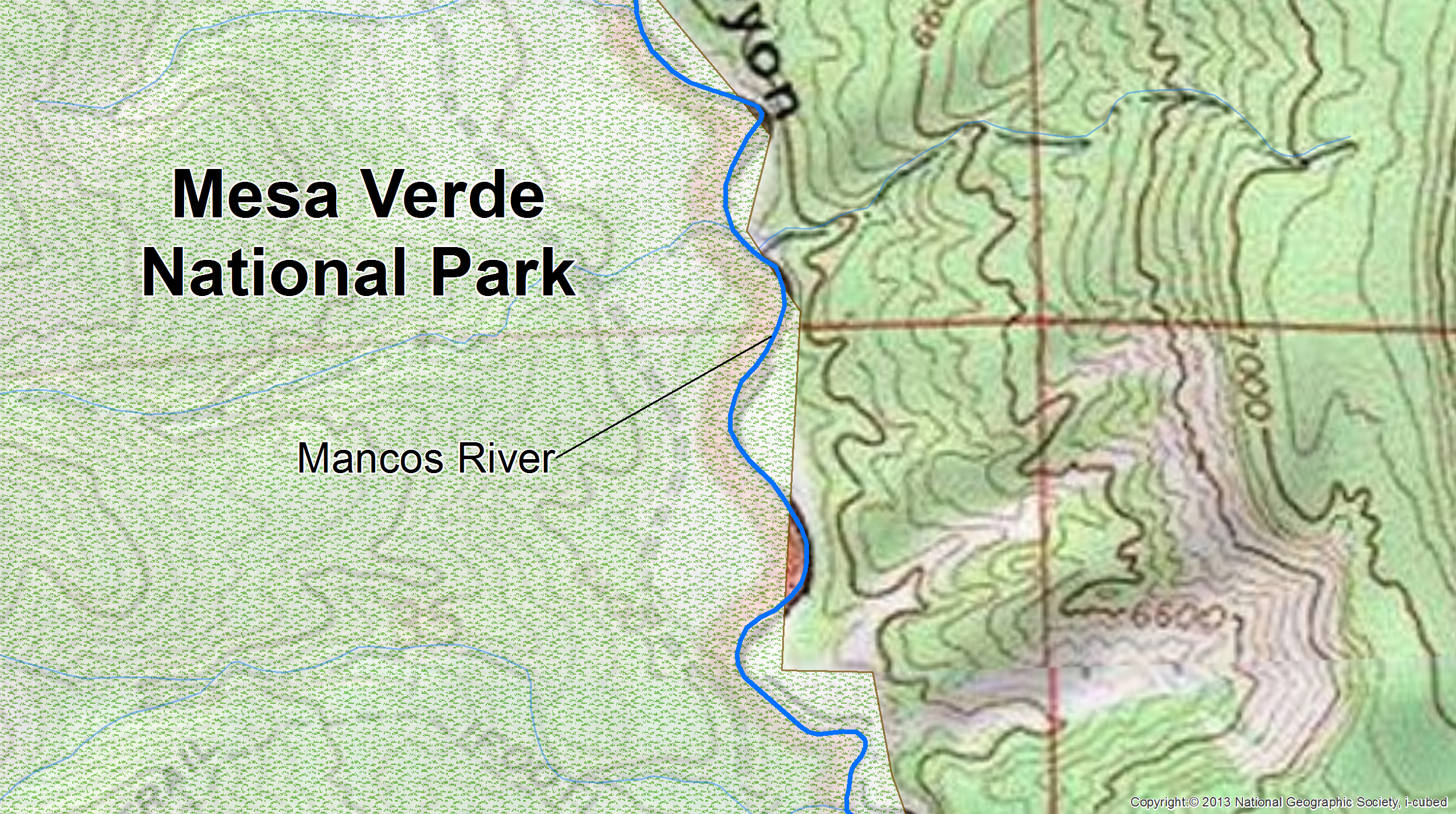
Mesa Verde National Park
This example of adjacency is rather clear cut. Since the Mancos River (blue) is contiguous with the Mesa Verde National Park boundary, it was included in the adjacent perennial stream statistics.
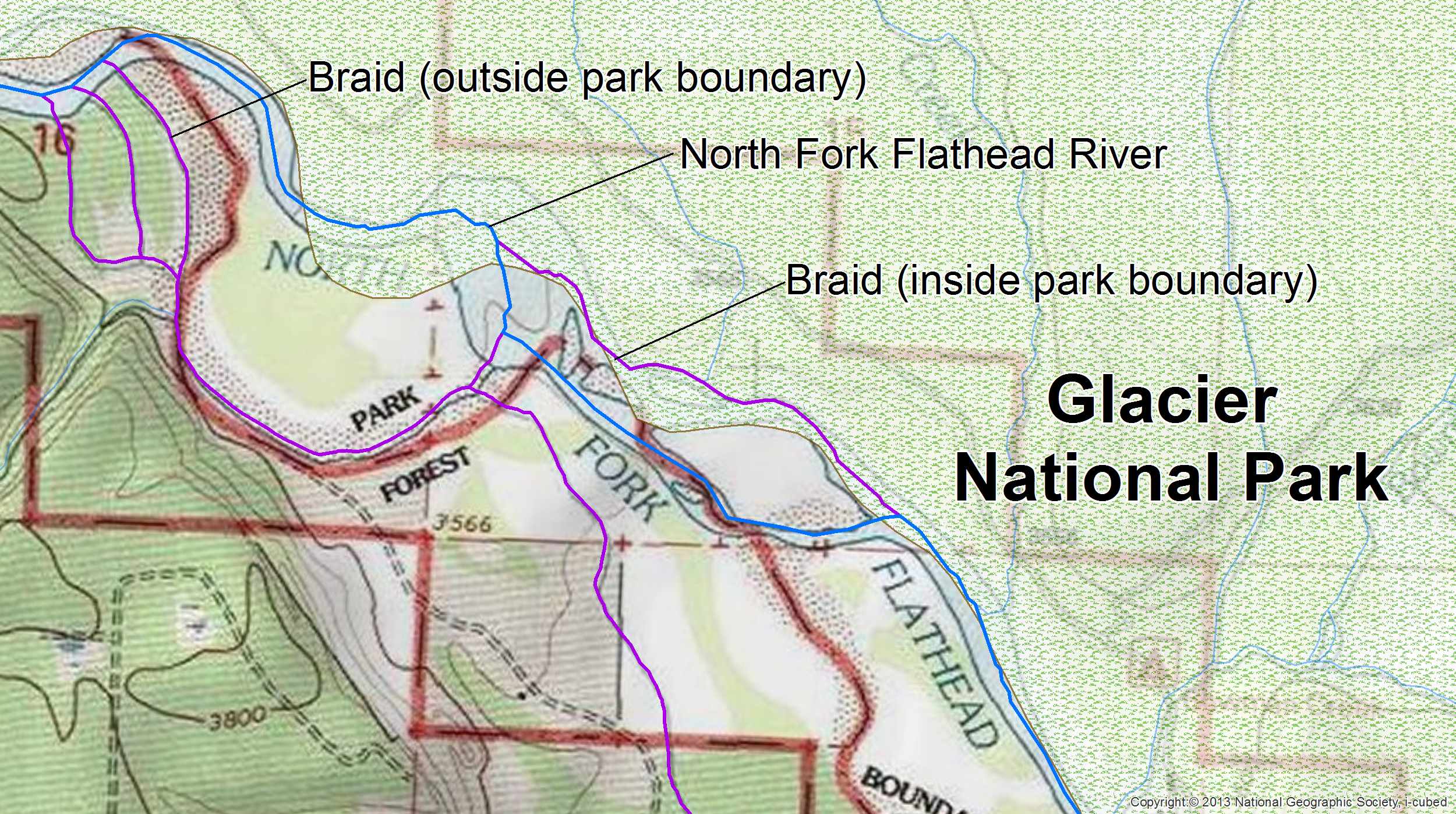
Glacier National Park
The North Fork Flathead River contains several braids (purple), some of which are outside of the park boundary. Although no one channel clearly shares a border with the park, the entire river system was attributed as adjacent; however, only the mainstem (blue) of the river actually counts towards the adjacent perennial statistics. Refer to the centerline attribution section below for more detail.
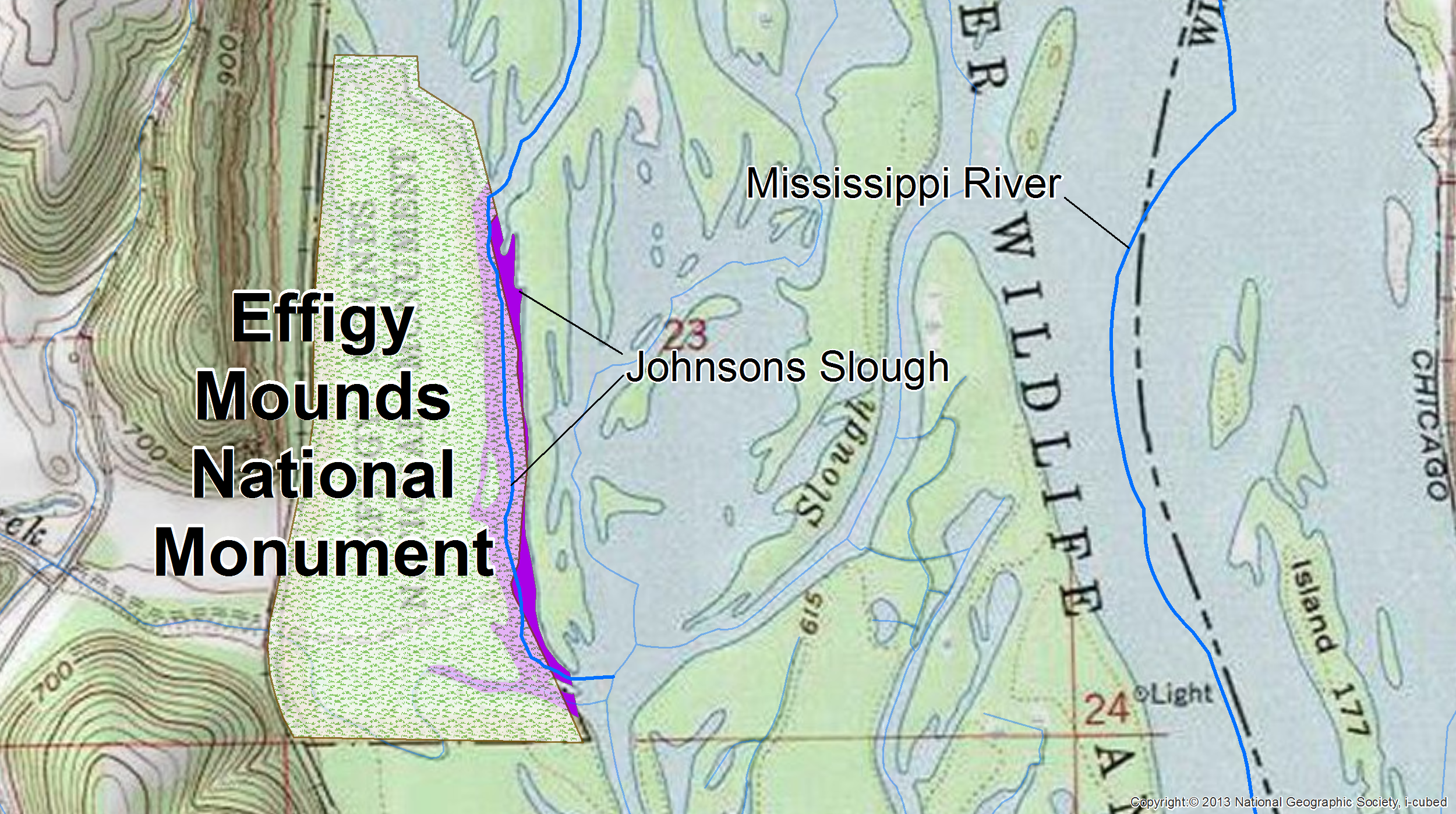
Effigy Mounds National Monument
This figure depicts two adjacency issues in the southern parcel of Effigy Mounds National Monument. First, the linear portion of Johnsons Slough (blue) and the areal portion (purple) do not appear to be adjacent to the park (since it is well within the park boundary). According to segment and topographical maps, however, Johnsons Slough is indeed adjacent and should not fall within the park. The other adjacency issue is that Johnsons Slough is a braided segment of the Mississippi River. A judgment call was made to exclude the Mississippi River to prevent overestimation of stream/river statistics. This decision was also heavily influenced by land ownership and the location of the Upper Mississippi River National Wildlife and Fish Refuge. In this situation, only the adjacent linear segment of Johnsons Slough and the purple areal polygon were attributed as adjacent in HIS.
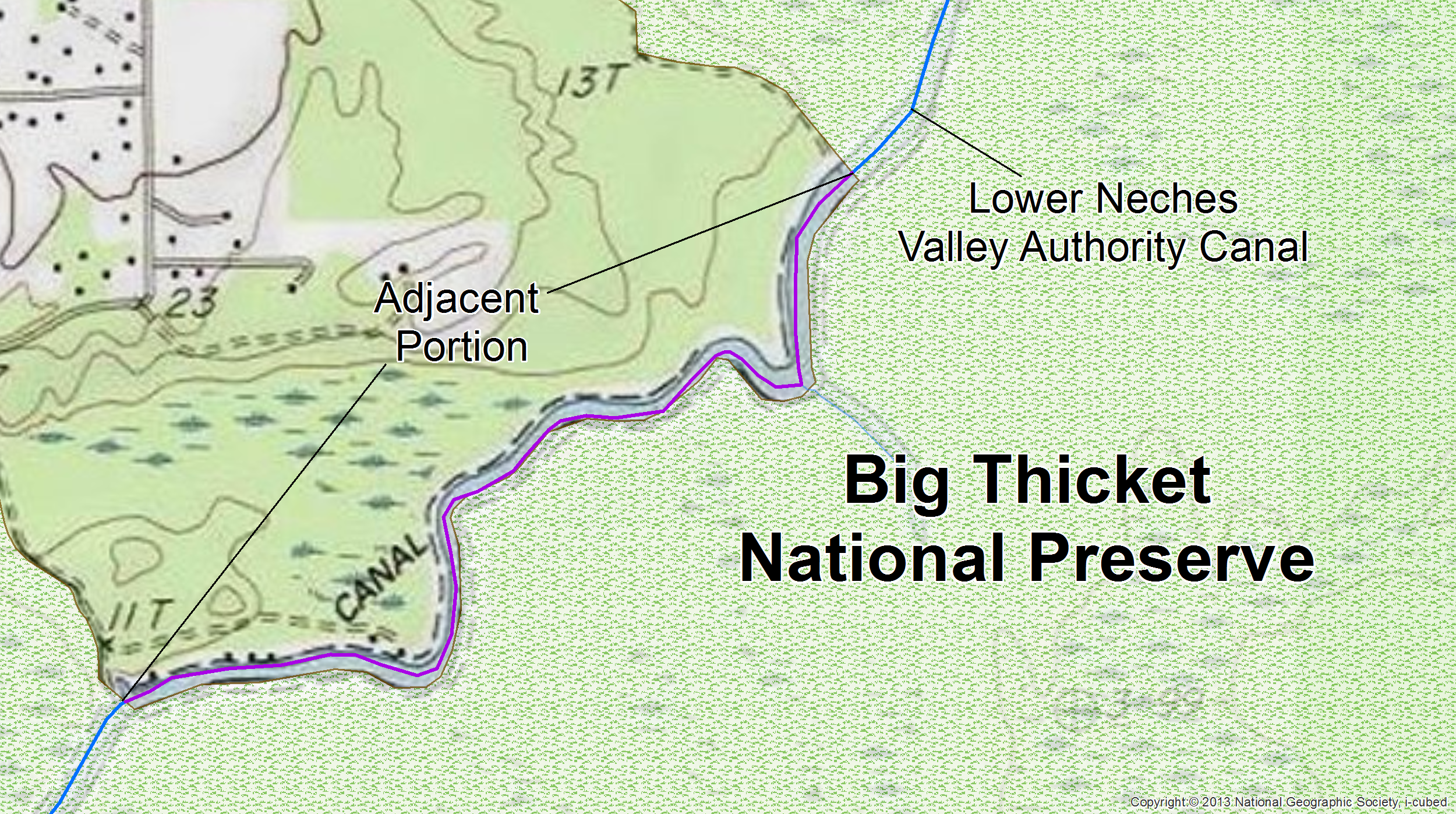
Big Thicket National Preserve
In Big Thicket National Preserve, only a portion of the Lower Neches Valley Authority Canal is adjacent to the park (purple). The straddling section was parsed from the rest of canal and identified as adjacent.
Attributing for Centerline
Linear features within the NHDFlowline feature class not identified as centerlines weren't included in a park's hydrographic statistics. This was especially handy when dealing with "branches" and "braids," which were not considered part of the main river system. Below are examples of centerline attributions:
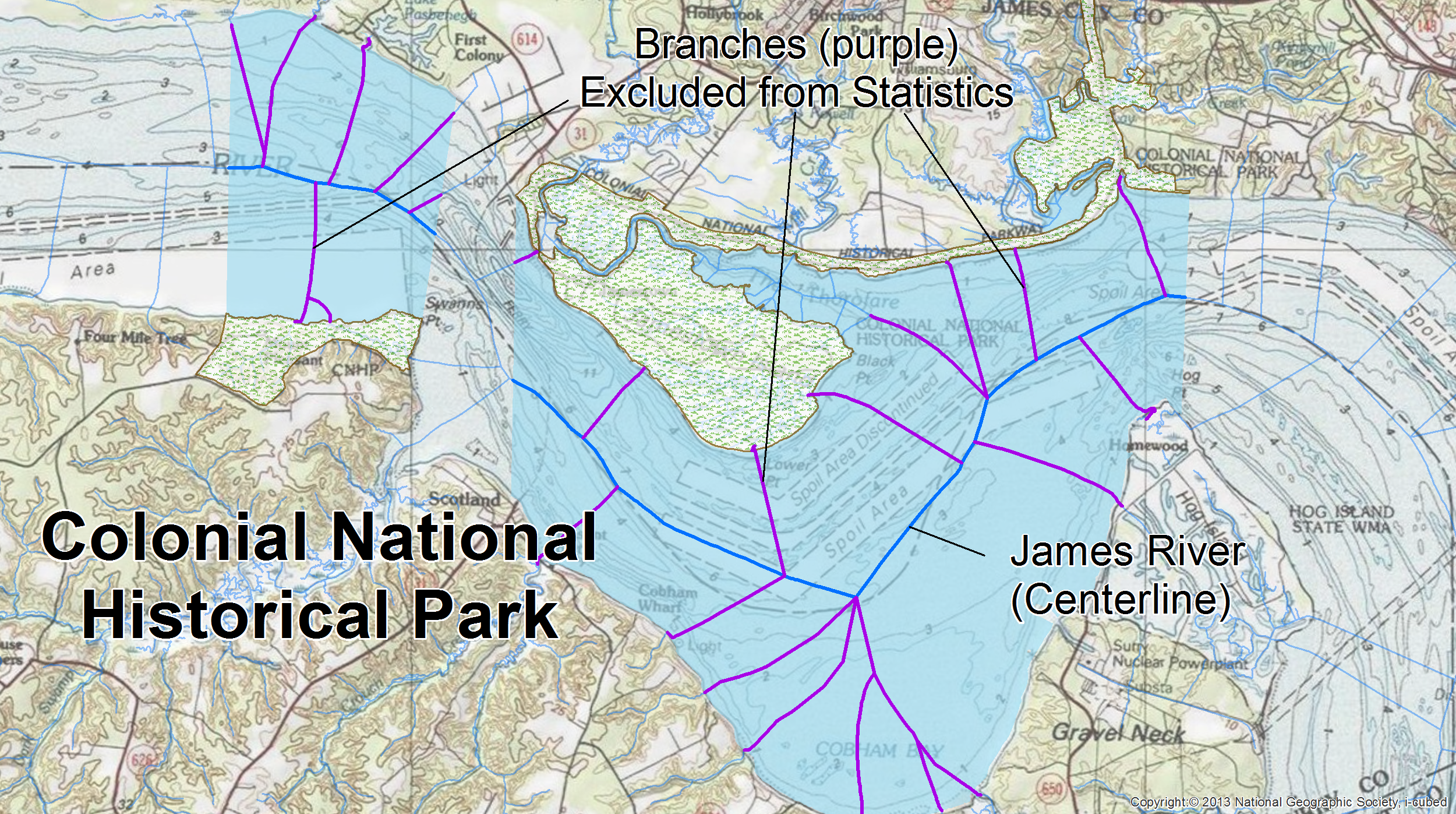
Colonial National Historical Park
The adjacent James River is represented as both a linear and polygonal feature. Several flowlines (purple) fall within the polygon to connect tributaries to the center pathway that is James River (blue). These flowline "branches" exist in NHD to enforce network connectivity in order to model water flow. Therefore, they were not tagged as centerlines and, consequently, were excluded from the park's hydrographic statistics.
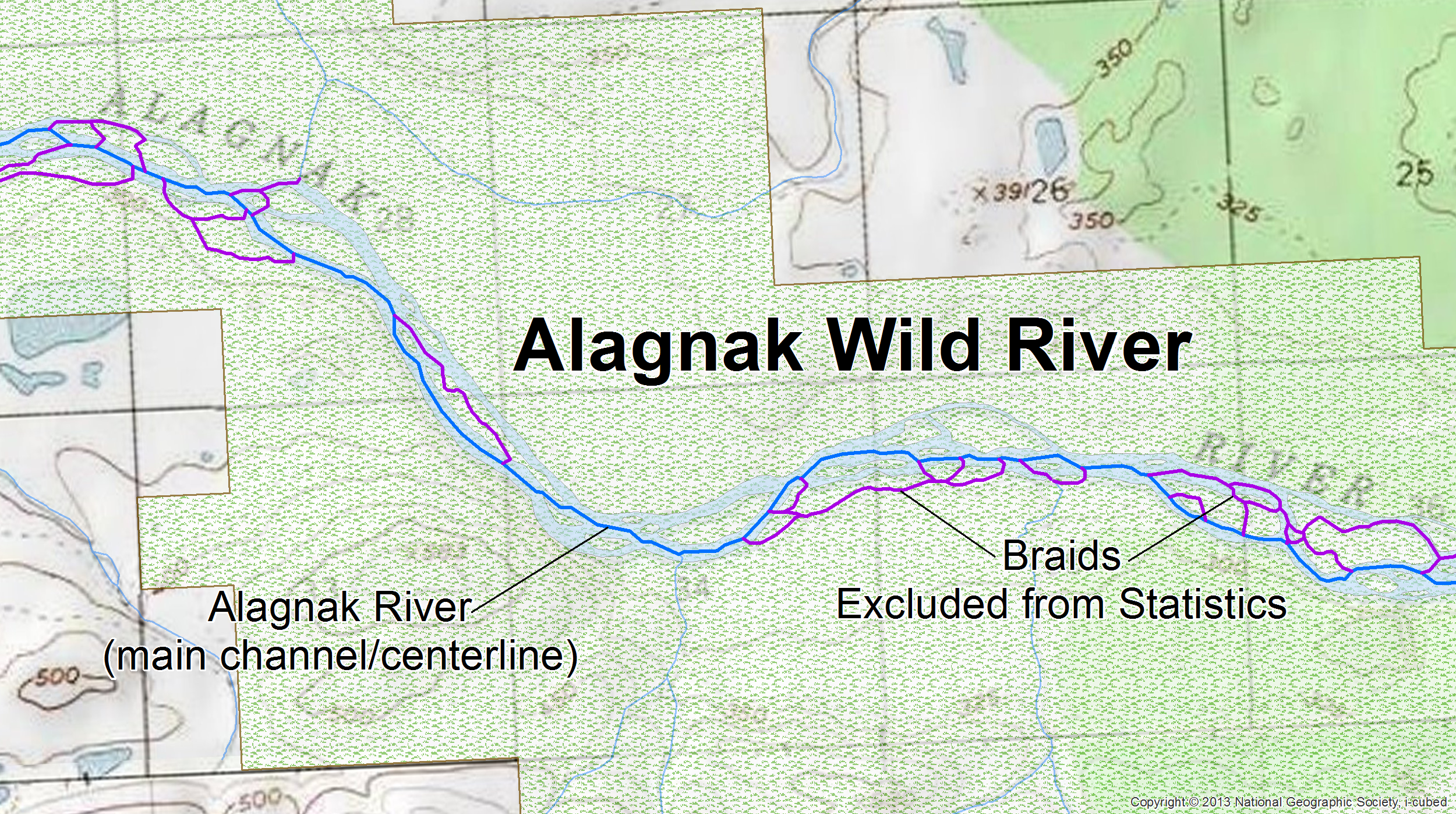
Alagnak Wild River
The Alagnak River in Alaska is a complex river system that contains several braids (purple). Only the main channel (blue) of the river system is included in the statistics. The main channel is identified either by lowest NHD stream level or by USGS Geographic Names Information System (GNIS) attribution. Only the main channel is tagged as a centerline and included in the hydrographic statistics.
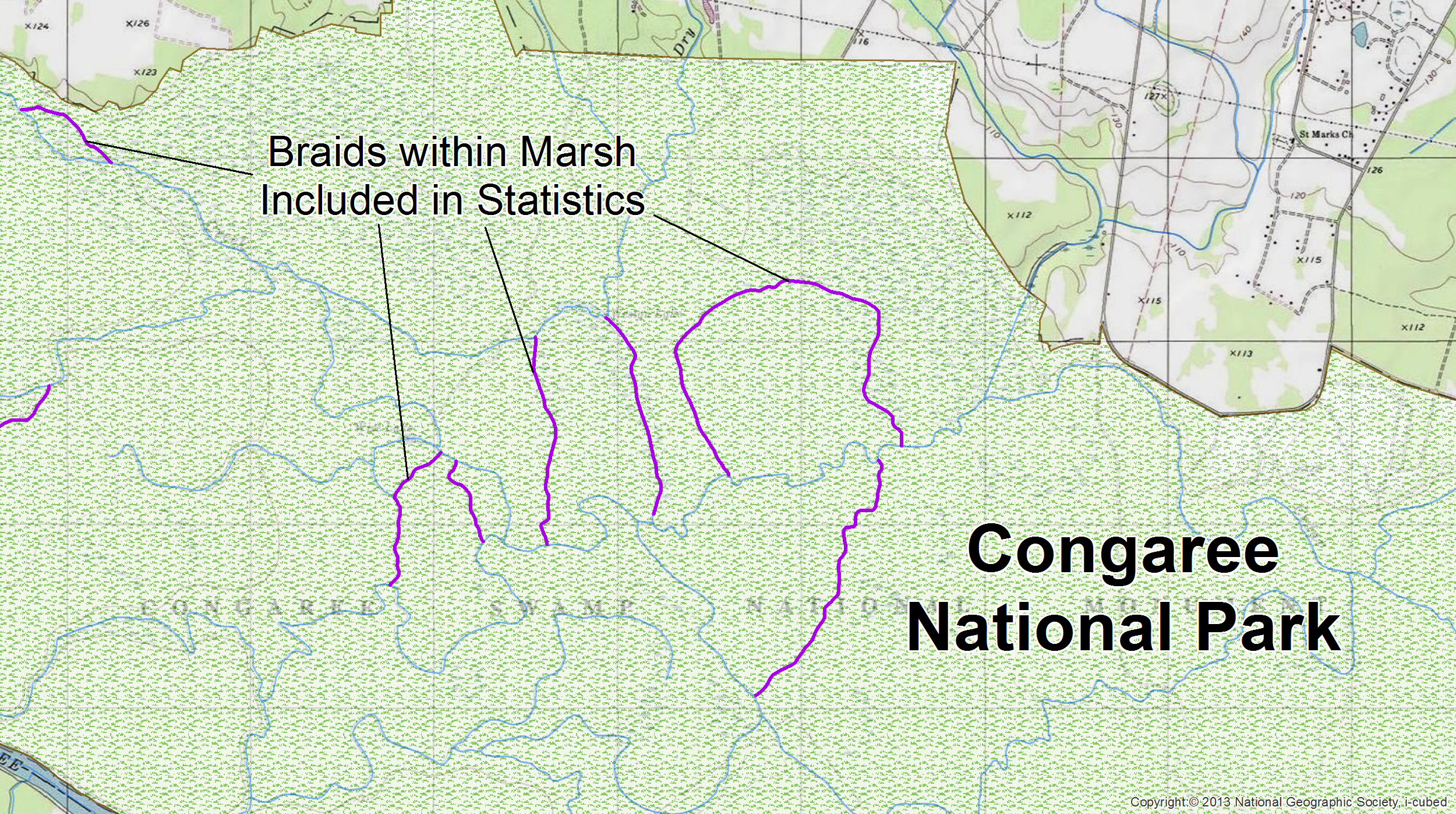
Congaree National Park
Parsing out centerlines for river systems located within swampy areas was often impractical. This is illustrated in Congaree National Park where several braids (purple) are distributed throughout the marsh. In these situations, all flowlines were tagged as centerlines and included in the stream statistics.
Similar to attributing for adjacent water features, tagging centerlines also requires some level of judgment from the processor. In situations where a braid extends for several miles, it is up to the processor to decide whether or not to include such a braid in the stream statistics. Consequently, not all instances encountered were as straightforward as the ones depicted above, especially for Alaskan parks where braids are ubiquitous. Parsing out centerlines in Alaskan parks required a great deal of time and effort and is prone to subjectivity and error.
Attributing "Artificial Paths" as Rivers and Canals
Artificial paths (NHD feature code 55800) exist in the NHDFlowline feature class and are assigned to features that overlap any polygonal features in the NHDArea and NHDWaterbody feature classes. The purpose of an artificial path is to delineate the direction of flow into and out of polygonal features. Artificial paths do not distinguish themselves as intermittent streams, canals, etc. Therefore, they must be reclassified to be properly accounted for in the hydrographic statistics. Below are two examples of how artificial paths were reclassified into rivers or canals:
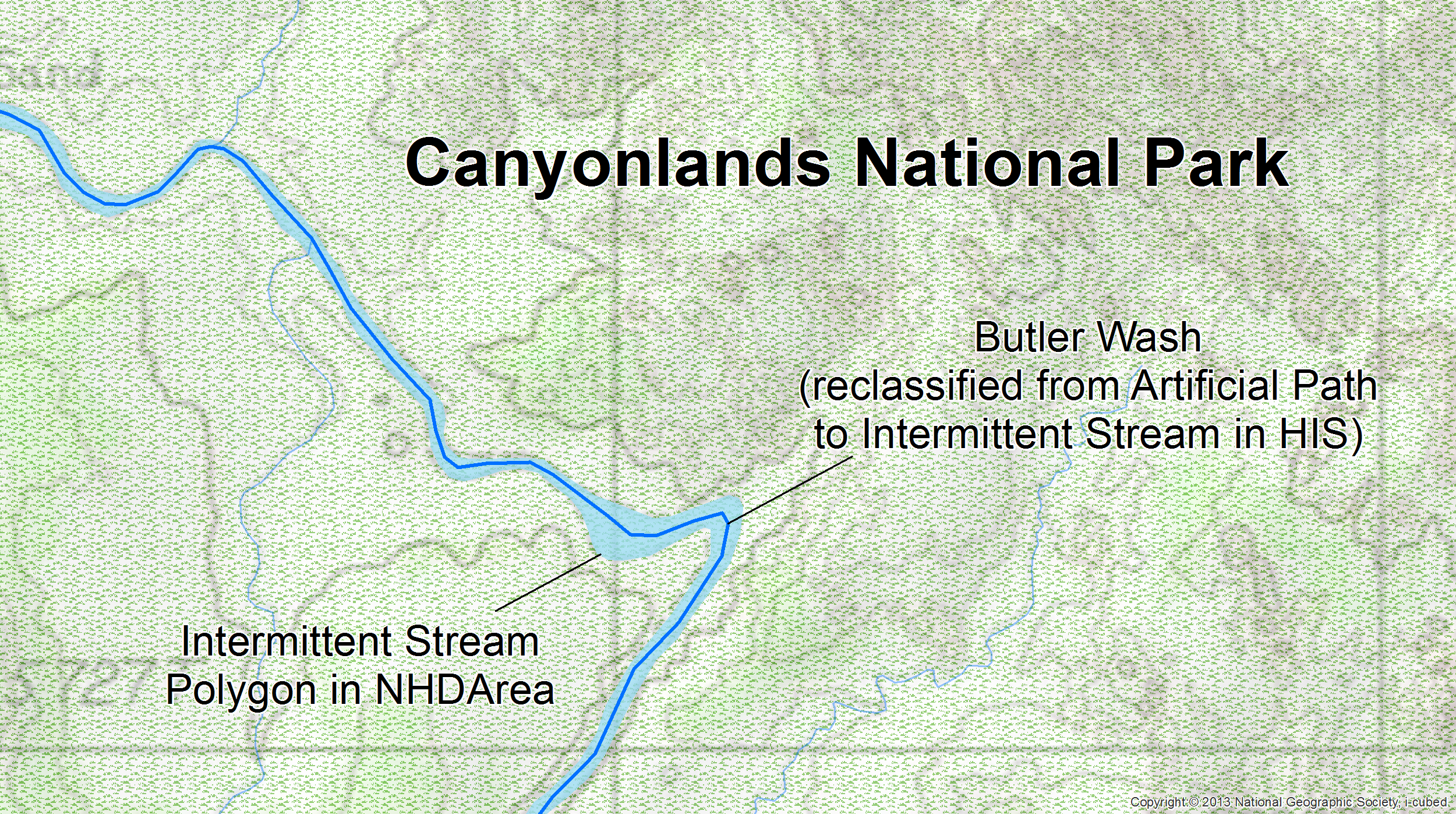
Canyonlands National Park
Centerlines that overlap polygons classified as intermittent streams were reclassified from artificial paths to intermittent streams. This situation was especially prevalent in Intermountain Region parks such as Canyonlands National Park. Since Butler Wash was classified as an intermittent stream polygon in NHDArea, the centerline artificial path was reclassified as an intermittent stream in HIS flowline statistics.
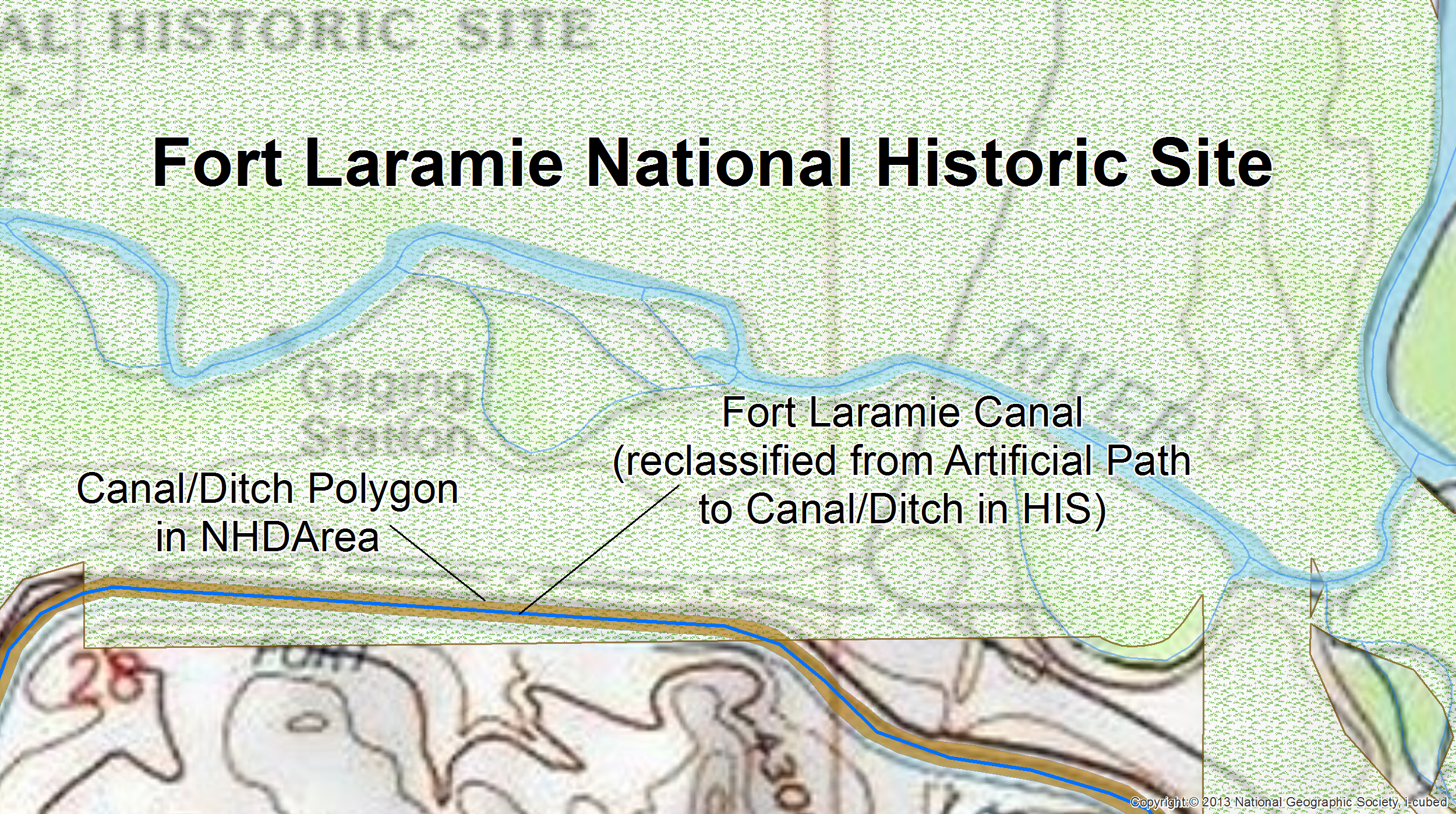
Fort Laramie National Historic Site
Artificial path features that are centerlines and are located within canal polygons in NHDArea (brown) were reclassified to canal/ditch in HIS linear statistics. For example, a canal runs through the southern portion of Fort Laramie National Historic Site. The artificial path (blue) that represents the Fort Laramie Canal was reclassified as a canal to obtain the appropriate canal mileage for the park.
Attributing for Shared Water Features
The sum of hydrographic statistics from all national park units does not equal the overall service-wide statistics due to shared water features among parks with adjacent boundaries. Although a particular waterbody may be included within both individual parks' statistics, it is only counted once in the service-wide statistics. While shared water features are included in each parks' statistics, they are only counted once in the service-wide statistics; consequently, the sum of all park statistics will not equal the service-wide statistical summary.
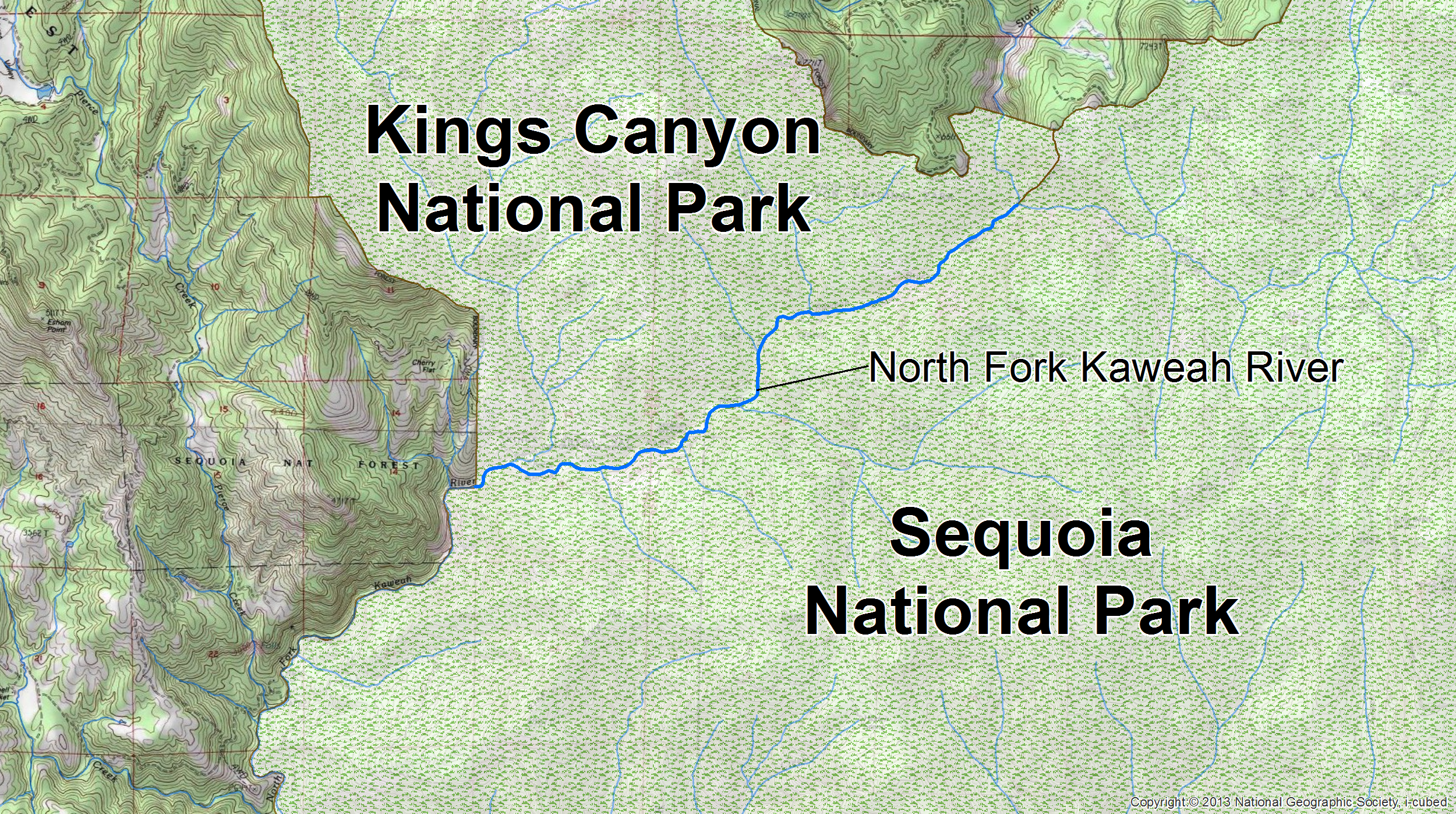
Sequoia and Kings Canyon National Parks
In the case of Sequoia and Kings Canyon National Parks, each park gets credit for the 3.84 mile shared portion of the North Fork Kaweah River, but, to avoid double-counting, the service-wide summation only includes this segment once.
Below is a table that lists the parks within the HIS database that have shared water features:
| Park | Shares Water Features With |
| Alagnak Wild River | Katmai National Park & Preserve |
| Appalachian National Scenic Trail | Delaware Water Gap National Recreation Area Middle Delaware National Scenic River Harpers Ferry National Historical Park Chesapeake and Ohio Canal National Historical Park Great Smoky Mountains National Park Shenandoah National Park Blue Ridge Parkway |
| Big Hole National Battlefield | Nez Perce National Historical Park |
| Blue Ridge Parkway | Appalachian National Scenic Trail |
| Chesapeake and Ohio Canal National Historical Park | Appalachian National Scenic Trail Harpers Ferry National Historical Park George Washington Memorial Parkway Rock Creek Park |
| Delaware Water Gap National Recreation Area Middle Delaware National Scenic River |
Appalachian National Scenic Trail |
| Fort Caroline National Memorial | Timucuan Ecological and Historic Preserve |
| Fort Washington Park | George Washington Memorial Parkway Piscataway Park |
| George Washington Memorial Parkway | Chesapeake and Ohio Canal National Historical Park Rock Creek Park National Capitol Parks National Capitol Parks Central Fort Washington Park Piscataway Park Theodore Roosevelt Island National Memorial |
| Golden Gate National Recreation Area | Point Reyes National Seashore |
| Great Smoky Mountains National Park | Appalachian National Scenic Trail |
| Harpers Ferry National Historical Park | Chesapeake and Ohio Canal National Historical Park Appalachian National Scenic Trail |
| Katmai National Park & Preserve | Alagnak Wild River |
| Kings Canyon National Park | Sequoia National Park |
| National Capitol Parks | George Washington Memorial Parkway Theodore Roosevelt Island National Memorial National Capitol Parks Central |
| National Capitol Parks- Central (National Mall & Memorial Parks) | Theodore Roosevelt Island National Memorial National Capitol Parks George Washington Memorial Parkway |
| Nez Perce National Historical Park | Big Hole National Battlefield |
| Piscataway Park | George Washington Memorial Parkway Fort Washington Park |
| Point Reyes National Seashore | Golden Gate National Recreation Area |
| Rock Creek Park | Chesapeake and Ohio Canal National Historical Park Theodore Roosevelt Island National Memorial George Washington Memorial Parkway |
| Sequoia National Park | Kings Canyon National Park |
| Shenandoah National Park | Appalachian National Scenic Trail |
| Theodore Roosevelt Island National Memorial | George Washington Memorial Parkway National Capitol Parks Rock Creek Parks |
| Timucuan Ecological and Historic Preserve | Fort Caroline National Memorial |
Attributing for Park
Hydrography for each park was organized and processed within its own unique personal geodatabase. All clipped hydrography was tagged with the four letter park unit code.
Assessing Lake Counts in NHDWaterbody
A field called "LakeCountID" was added to the clipped NHDWaterbody feature class to quantify the number of lakes, ponds, and reservoirs within each park. In the field calculator of the attribute table, the "LakeCountID" field was set to equal the "ObjectID," which gave each feature a unique value in the "LakeCountID" field. Only features with an FCODE of 390xx, 36100, 43613-43619, and 43621 were included in the lake count statistic. Polygons that represent the same waterbody feature were given identical values in the "LakeCountID" field. Statistics for lake counts were derived using the number of unique values in the "LakeCountID" field. Subjectivity was required when assessing park lake counts. For more information, check out the Lakes Counts in NHD section on the HIS Caveats page. Below are some examples of how Lake Counts were evaluated in different parks:
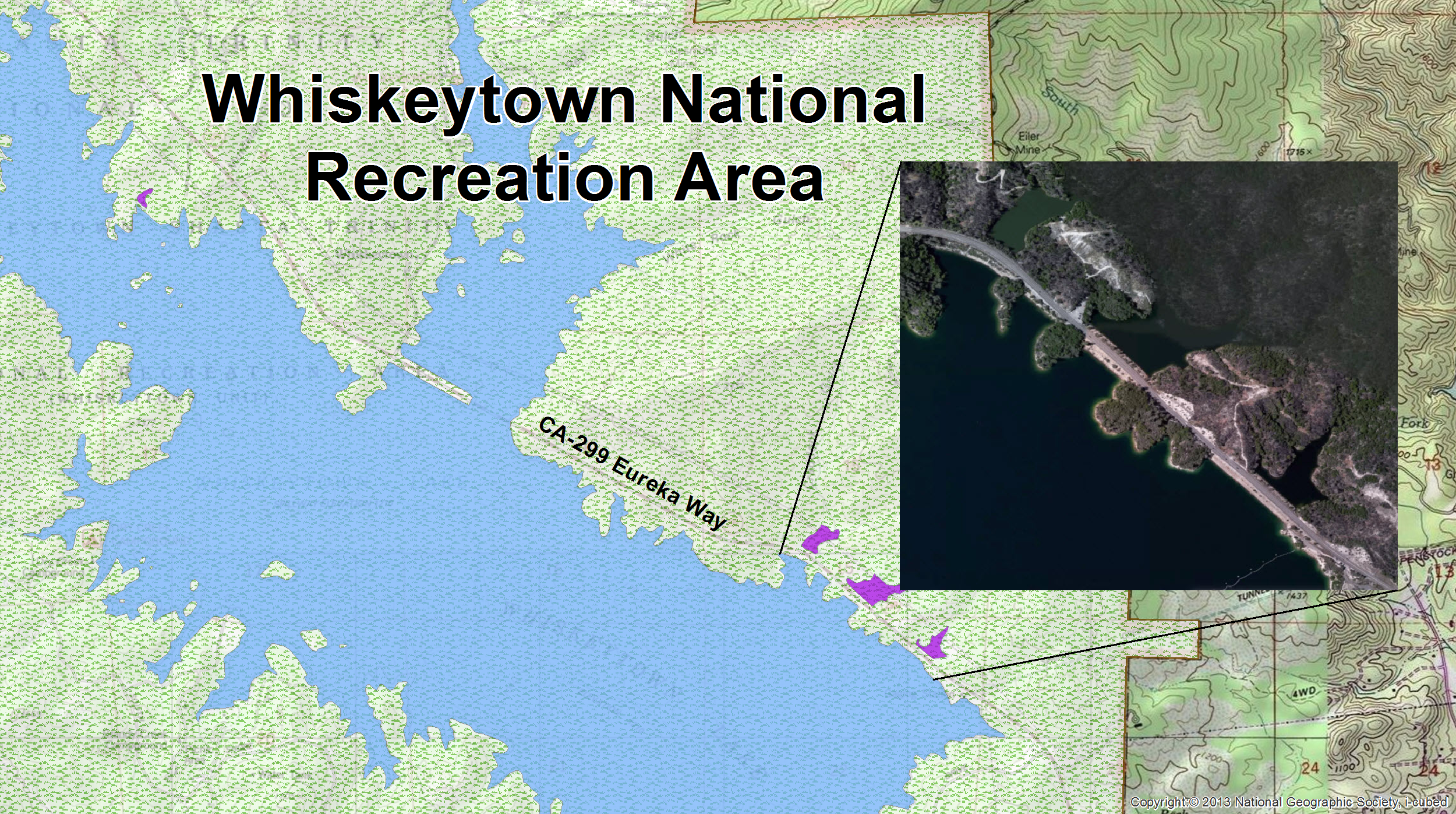
Whiskeytown National Recreational Area
Whiskeytown Lake exists in NHD as seven separate polygons. As shown by this image, the tiny polygons (purple) that are nearly adjacent to the primary Whiskeytown Lake are also part of the lake, but separated by a road (or several bridge crossings). Consequently, all seven polygons were assigned identical values in the "LakeCountID" field to account for there only being one Whiskeytown Lake. Failure to follow this step would result in counting Whiskeytown Lake seven times.

Lower Saint Croix National Scenic Riverway
When assessing lake counts, NHD shows adjoining waterbody polygons that have separate GNIS names. As shown in Lower Saint Croix National Scenic Riverway, the blue polygons are Rice Lake, Peaslee Lake, and Lower Lake. In situations where adjoining polygons have different GNIS names, they are each given a unique value in the "LakeCountID" field so they will be counted as separate lakes/reservoirs.
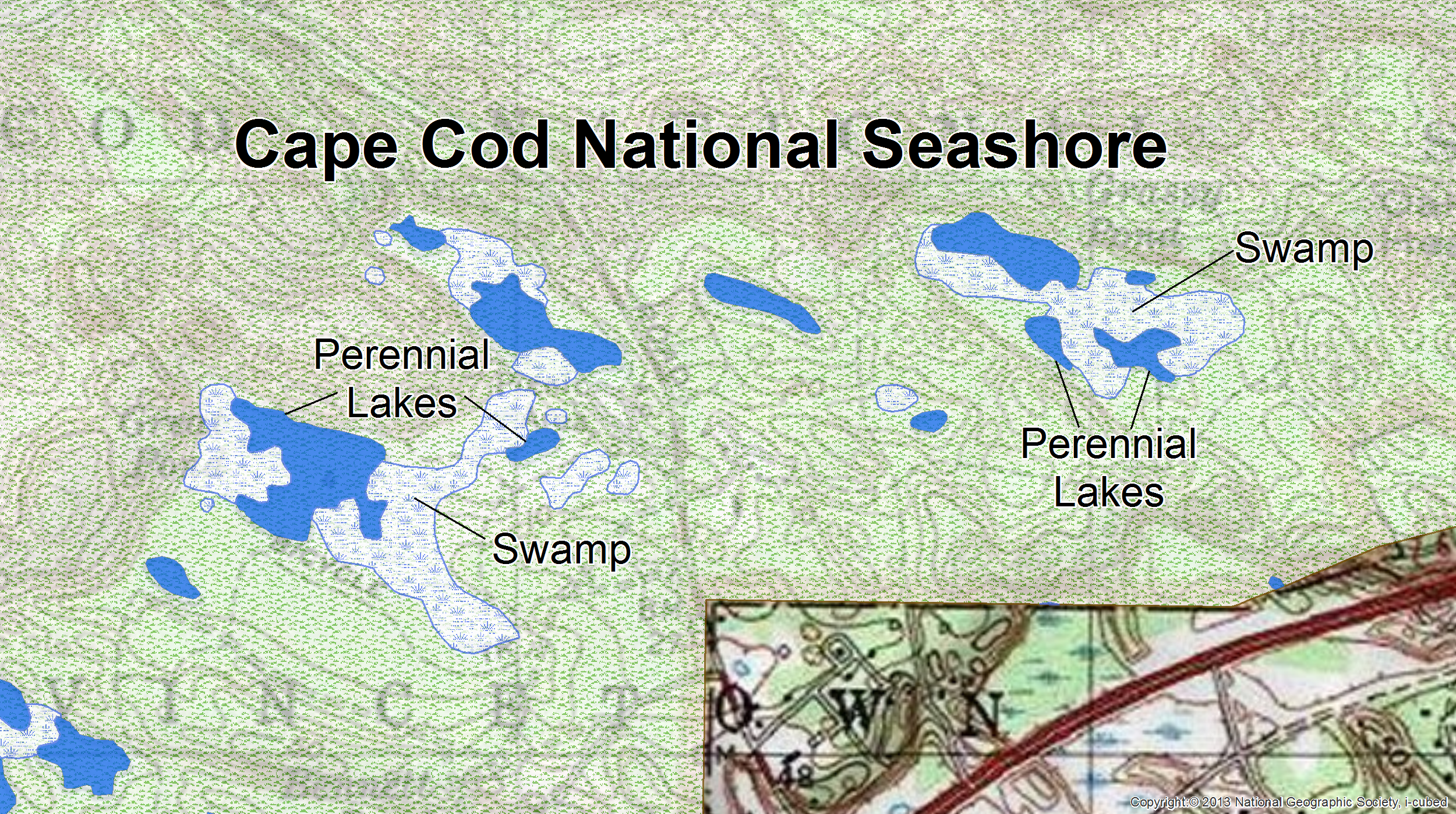
Cape Cod National Seashore
Quantifying lakes becomes difficult when they are located within marshy and/or estuarine areas. In the case of Cape Cod National Seashore, each blue polygon represents a pond identified by NHD. Since the number of lakes within marshy areas is bound to vary (especially for coastal parks), each polygon was given a unique value in the "LakeCountID" field.
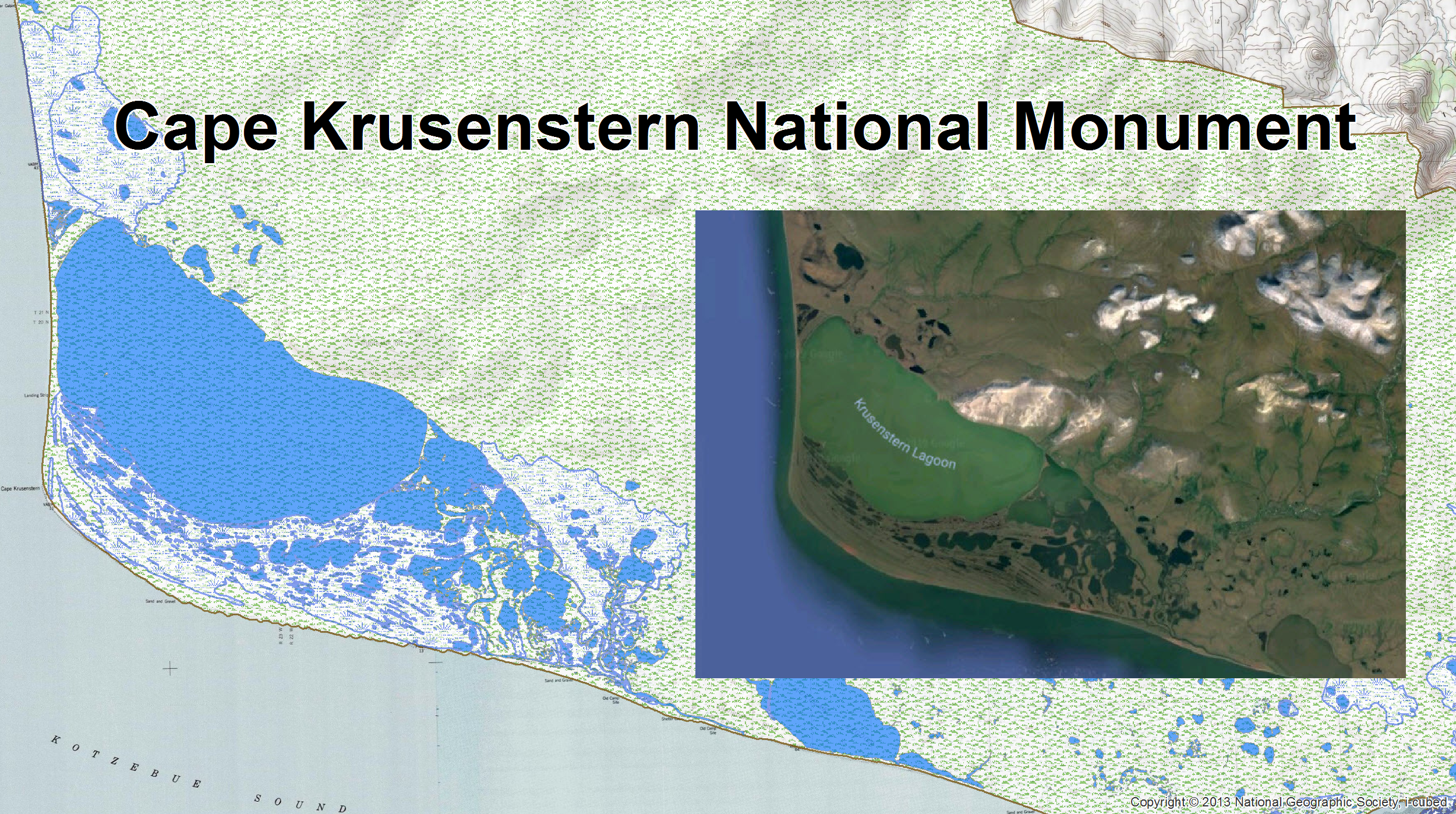
Cape Krusenstern National Monument
Coastal parks, such as Cape Krusenstern National Monument, may have varying numbers of lakes depending on the tide level. In this instance, several lakes are located within a marsh/estuarine area that is tidally influenced. In most coastal parks, unless lakes are inland and are not tidally influenced, then quantification of lake counts is strictly dependent on NHD delineation. Therefore, in Cape Krusenstern National Monument, each blue polygon was given a unique value in the "LakeCountID" field.
Attributing for 303(d) Impairments
Clean Water Act (CWA) 303(d) impairments were georeferenced to the NHD. Georeferencing is the process of locating an entity in "real world" coordinates. As applied to this project, georeferencing consisted of adding 303(d) entity IDs to those NHD records which were 303(d) impaired. 303(d) entity IDs are unique IDs assigned to impaired waterbodies by the State and represent an assessment unit (check out the 303(d) Impairment Statistics on the HIS Caveats page). To determine which waterbodies were impaired and the geospatial extent of the impairments, WRD primarily relied upon the State water quality reports (CWA 303(d), 305(b) and Integrated Reports) and State assessment shapefiles (if available).
All data sources used by the WRD have their limitations. State assessment shapefiles were only available from some States. In addition, state GIS data may be created at a resolution that differs from the NHD. State 303(d) lists provided the most current listings, but sometimes offered poor textual descriptions of the geospatial extents. In some instances, only sampling stations were identified as impaired with no indication of upstream or downstream extent. Similarly, in coastal areas, States frequently made no effort to describe the geospatial extent of impaiments other than to locate the sampling stations. Since this project necessitated that all park impairments be georeferenced to NHD in order to calculate miles and acres of impairments, assumptions and judgment calls were often necessary.
Relate tables were created to house the impairment data (e.g. pollutants, sources, year listed, etc.) using the 303(d) entity ID as the relational key. Typically the impairment data was taken directly from State water quality reports and related to NHD features in HIS.
Measuring the Clipped NHD
Prior to processing the hydrography for each park, the data frame within ArcGIS was projected on-the-fly to its appropriate Universal Transverse Mercator (UTM) zone. This was particularly challenging for some Alaskan parks, as their spatial extent may intersect multiple UTM zones. In those cases, the UTM zone that covered the majority of the park was selected. Parks within the U.S., Puerto Rico, and Virgin Islands were processed using North American Datum (NAD) 1983 UTM zones. However, parks in the Pacific Islands (i.e. Guam and American Samoa) were processed using World Geodetic System (WGS) 1984 UTM zones. The length, perimeter, and area of the clipped NHD features were calculated using the "Calculate Geometry" tool for vector analysis. It is important to note that the "Calculate Geometry" tool generates planimetric measurements and does not produce surface length or area. Therefore, a certain degree of error is to be expected within the calculations, especially when processing hydrography for parks with high degrees of varying elevations and slopes.
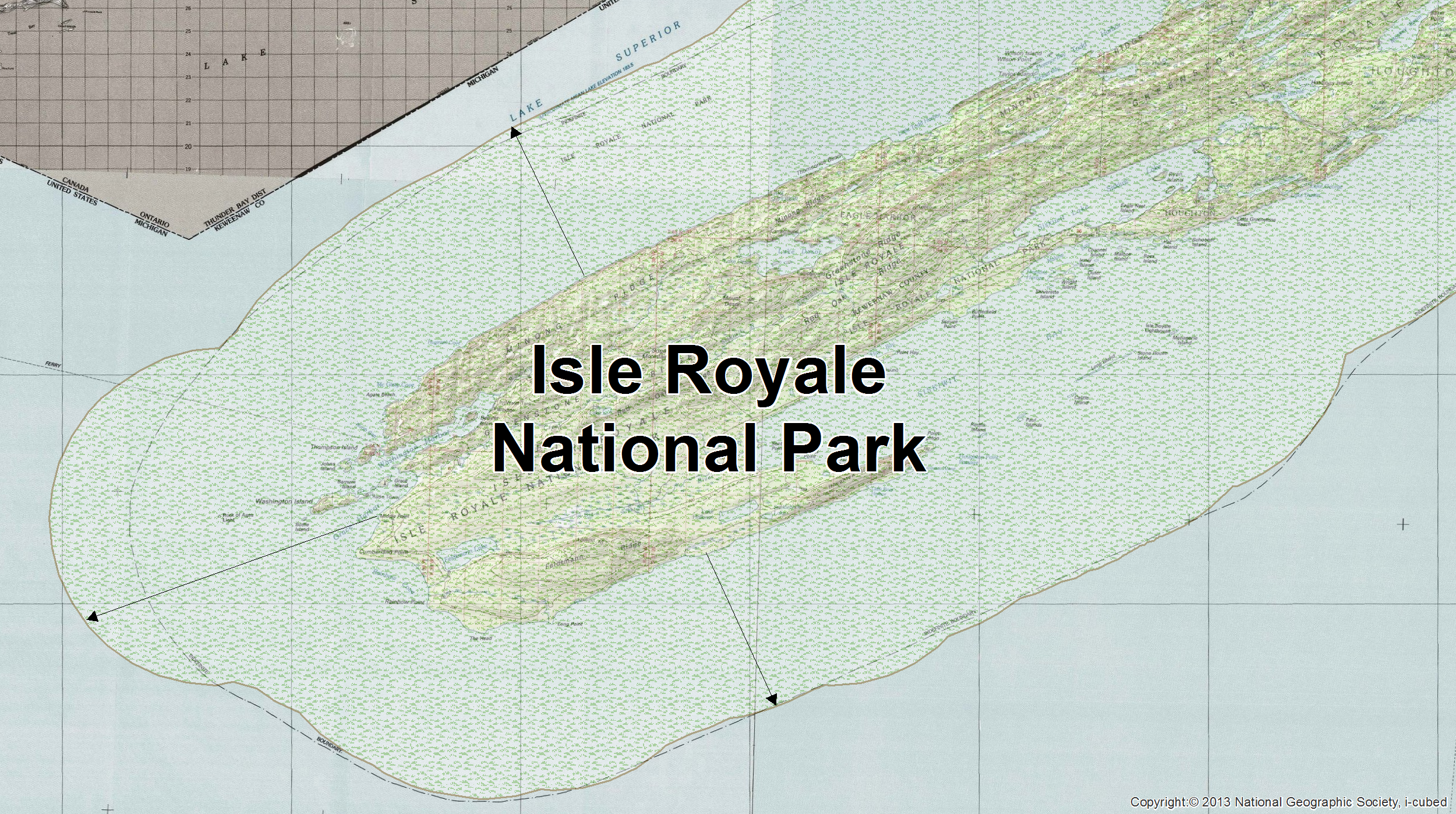
Shoreline statistics were derived by converting lake/pond/reservoir/ocean polygons into polylines. The polylines that represent the perimeter of the clipped polygons, however, do not reflect the true shoreline mileage. As a result of clipping the polygons to the park boundary, any polygonal features that intersect the park boundary will contain "false" shorelines.
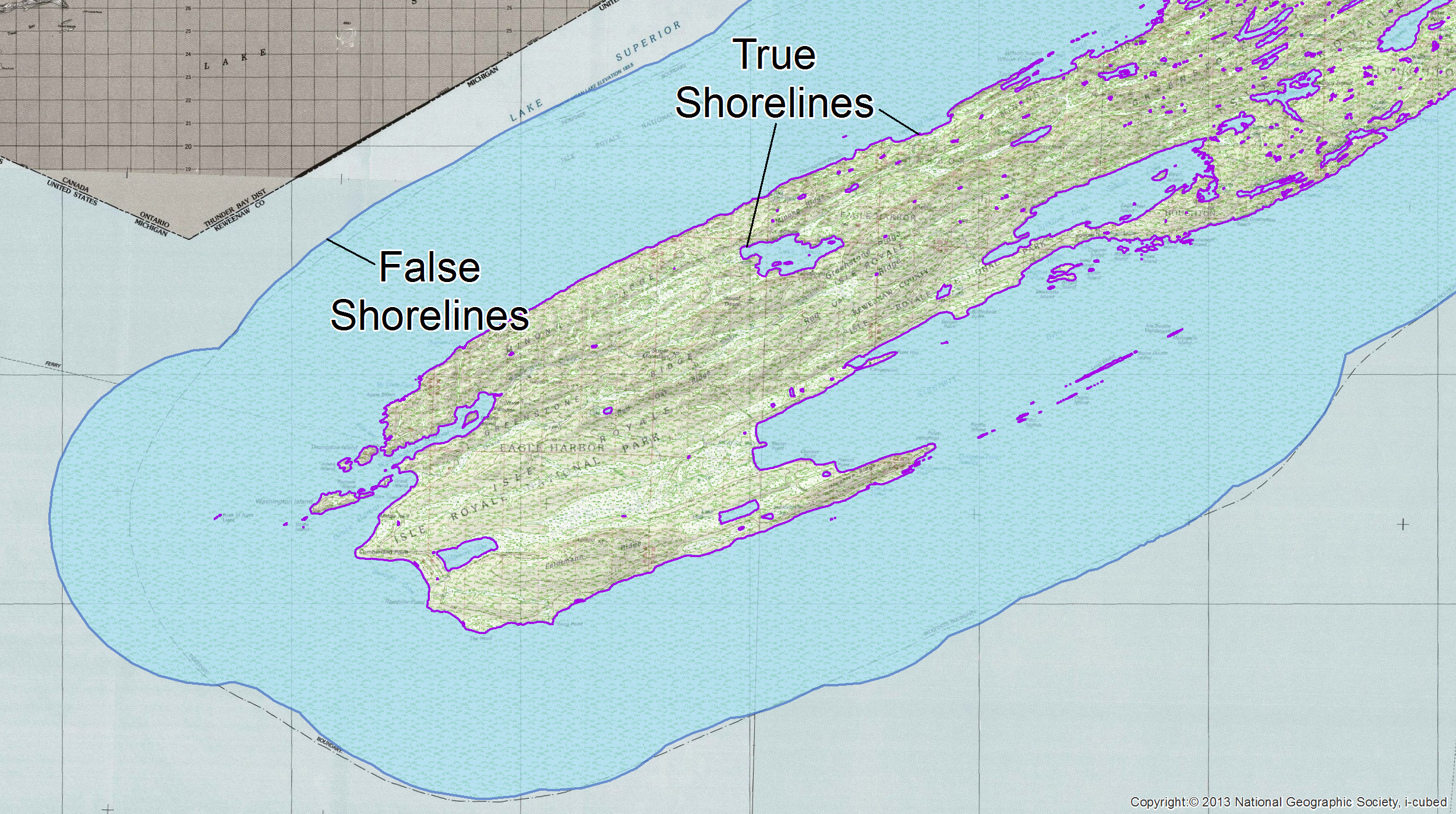
"False" shorelines were manually deleted using the split tool. The "Calculate Geometry" tool was employed to calculate miles of all true shorelines within each park. The concept of "false" shorelines is illustrated to the right by overlaying the Isle Royale National Park boundary with the clipped lake/pond/reservoir polygons in NHDWaterbody.
Relating the Clipped Hydrography
Linear features within the NHDFlowline feature class were clipped to the park boundary and then exported as an event table using ArcGIS Linear Referencing tools. The event table uses reach codes from NHDFlowline as its route reference. Several fields were then added to the event table to attribute for park, centerline, adjacency, stream, canal, CWA 303(d) entity ID, and length. Impaired flowlines that were assigned an entity ID were combined into a separate event table using the "Dissolve Route Events" tool. Clipped polygonal features were assigned unique IDs for each record. Within individual park geodatabases, relate tables were created that link the unique IDs with various attributes such as adjacency, park unit, and CWA 303(d) entity IDs.

A separate relate table was created within each park geodatabase that contains impaired water features. This table contains CWA 303(d) impairment data and used the entity ID as the relational identifier. Information for impaired water features is maintained within this table and was derived from the most current state 303(d), 305(b), and Integrated Reports. A similar relate table was created within each park geodatabase that contains applicable CWA Antidegradation Policy information. This table contains information about outstanding resource waters (Tiers 2.5 and 3) such as the waterbody name, the geographic extent of each designation, and the designation assigned by the State.
Attribute and relate tables were imported into a master database where point, linear, and polygonal statistics were calculated. Statistical calculations were derived using queries and Visual Basic modules. Several QC procedures have been integrated to improve the accuracy of the statistics. The final product includes a spreadsheet of hydrographic and impairment statistics that can be viewed in both tabular and form views.
Last updated: October 4, 2021
